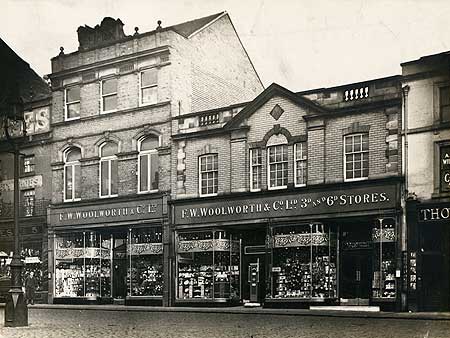The Potteries Museum and Art Gallery was larger than Claire and her husband expected.
Category: Hanley
The Old Swan Inn, Hanley
In his Romance of Staffordshire (Published in the 1870s), Henry Wedgwood describes the Swan Inn, a coaching inn where stagecoaches to London, Birmingham, Manchester and Liverpool stopped to pick up passengers. He writes:
It is wonderful how soon public buildings pass from memory. How completely the “Old Swan Inn”, Hanley, is now buried in the past and, along with the memory of those who met to socialise under its roof.
The old inn was a large building with strange-looking wings and gable ends, with square-built chimneys and gothic windows, some of them exceedingly small and mullioned by heavy stonework. There were iron palisades at the front of the inn and an extensive bowling green at the rear. The front entrance was covered by a flat canopy supported by stone pillars.
Inside there were queer, old, little rooms with chimney nooks and ancient screens that told of bygone days. There was one large room used by local clubs and for civic celebrations where speeches were made about the state of the pottery industry.
One of the rooms at the rear of the inn had a large bay window that overlooked the bowling green. In this room, the magistrates held petty sessions to try summary offences. They sent those suspected of committing indictable offences for trial at Quarter Sessions or the Assize Courts, which sat in the Shire Hall at Stafford.
(Edited by North Staffordshire Heritage)
Bull Baiting in 18th Century Hanley
Hanley’s bullring, where bulls were baited on Sundays, was near the Cock Inn at Far Green. Henry Wedgwood, in his Romance of Staffordshire, says the bullring was a place where ” some poor animal was attacked by dogs” and tortured by men. He writes:
Bull baiting was organised by men who frequented the Cock Inn, a small tavern with a thatched roof.
Writing about bull baiting, Wedgwood asks his readers to picture an infuriated bull made fast to a stake or a ring driven into the ground. The bullring was surrounded by hundreds of people – both men and women. Standing in front of the crowd were men restraining snarling dogs struggling to break free and attack the bull.
Spectators were betting on which dog would bring the bull to its knees. There were excited shrieks from its supporters when the dog they had bet on was sent into the ring. They cheered if the dog’s teeth tore flesh from the bull’s nose or another part of its body.
During the winter months, when bull baiting took place in the late afternoon or early evening, the ring was lit by torches made from long pieces of pit rope resoaked in pitch.
According to Wedgwood, the crowd surrounding the bullring was a drunken rabble that included colliers whose faces were as black as midnight and potters wearing leather aprons and breaches.
When the bull collapsed with exhaustion, its tormentors, egged on by the spectators, attempted to force it to get up by prodding it with sharp spikes or pouring hot tar onto the most tender parts of its body.
Law Enforcement in Hanley
Between 1842 and 1870, law and order in Hanley was maintained by Staffordshire’s county police force.
Although Hanley and Shelton, the two largest townships in the Potteries, amalgamated in 1857 to form the Borough of Hanley, the borough did not obtain its own police force until 1870.
Stanford Alexander was appointed chief constable. He had 35 police officers to maintain law and order in a town that had a population of 41,000. His officers worked three overlapping shifts – two 12-hour shifts during the day and one nine-hour shift at night. Despite the long hours worked, pay was low. Constables earned 21 shillings a week. Sergeants were paid 25 shillings, and inspectors received 30 shillings.
When Alexander retired in 1875, Herbert Windle was made chief constable. Windle improved pay and working conditions for his officers. He persuaded the town’s Watch Committee to give them a library and a recreation room, with a billiard table, where they could relax when they came off duty.
By the late 1870s, Hanley had become the Potteries’ commercial and cultural centre. Trains and trams brought people from neighbouring towns to its shops and markets, music halls and theatres.
On Saturday nights, Hanley’s criminal fraternity went to the town centre. Children begged outside shops or stole from market stalls. Drunken brawls broke out in public houses. Gangs roamed the streets looking for a fight. Prostitutes accosted men in Piccadilly. Pickpockets mingled with the crowds in Fountain Square, and robbers lurked in dark alleys waiting to pounce on their victims.
Robbery and theft were indictable offences. They had to be tried in Stafford before the Assize Court or by Quarter Sessions.
Police officers and witnesses were forced to travel to Stafford, where they had to wait outside the courtrooms in the Shire Hall until called to give evidence. Unwilling to make the journey, many victims of crime refused to prosecute offenders. Law and order in Hanley was breaking down. The borough council asked Queen Victoria to give the town its own Quarter Sessions. She granted the council’s request, and the borough’s Quarter Sessions held its first sitting on January 19, 1881. There were eight defendants, three of whom could neither read nor write.
Hanley and Shelton in the 18th century
During the 18th century, Hanley and Shelton became the most important towns in the Potteries.
Between 1762 and 1801, their populations increased from 2,000 to 7,940. Hanley’s first church, St. John’s, was erected in 1738 and enlarged in the 1760s. Stage coaches called at the Swan Inn. Horse-drawn wagons carried pottery to the Weaver Navigation at Winsford and returned carrying ball clay and household goods.
A covered market, designed by architect James Trubshaw, was built on Town Road in 1776.
The Trent and Mersey and the Caldon Canals stimulated economic expansion. Entrepreneurs opened factories, collieries and ironworks. Families from the surrounding countryside flocked to Hanley and Shelton looking for work, and new houses were erected to accommodate them.
In 1791, a trust was formed to manage the market and build a town hall. The trustees leased land in Market Square, where they erected a town hall. Markets were held on Wednesdays and Saturdays. A fortnightly cattle market was established at the beginning of the 19th century. In 1813, Parliament gave the trustees the power to regenerate Market Square. They demolished the town hall, replacing it with a poultry market and a lockup, where those arrested were held before being brought to court.
Memory Lane – Hanley Woolworths
There was something for everyone at Woolworth’s stores, which were on the High Street in major towns and cities throughout England and Wales.
Affectionately known as “Woolies”, these stores were like Aladin’s cave. They were stocked with a wide range of goods that attracted customers of all ages from all walks of life. Among the things you could buy at Woolworths were toys and games, chocolate and sweets, pop records and portable radios, car accessories, household paint, stationery and stamps, electric fires and fan heaters, garden furniture and plants… The list is endless.
Everyone who shopped at Woolworths will have memories of the store they bought from – its staff and the things they sold. If you and your family shopped at “Woolies” in Hanley, please share your memories and tell us what you bought.
Woolies Buildings - Then and Now
7-9 Upper Market Square, Hanley, Stoke-on-Trent, Staffs ST1 1PY
In 1915, World War One did not stop Woolworth expanding and they opened their 55th store on Upper Market Square in Hanley, Stoke-on-Trent. As with many war-time stores, it had a similar design to Kingston-upon-Thames (Store 43), with an open pediment and a Venetian window.
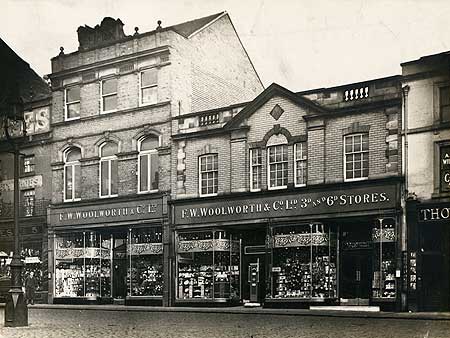 Hanley Woolworths 1920s
Hanley Woolworths 1920s
Source: Historic England
In 1937 the store had a makeover, and as it was a long-store, the design was Art Deco with a centrepiece at the top.
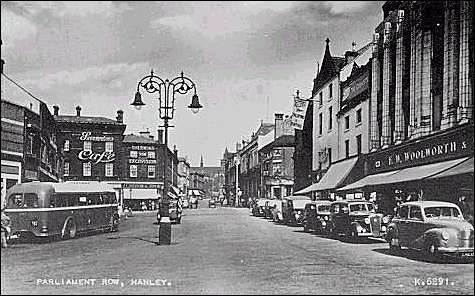 Hanley Woolworths 1950s
Hanley Woolworths 1950s
Source: ThePoterries.org
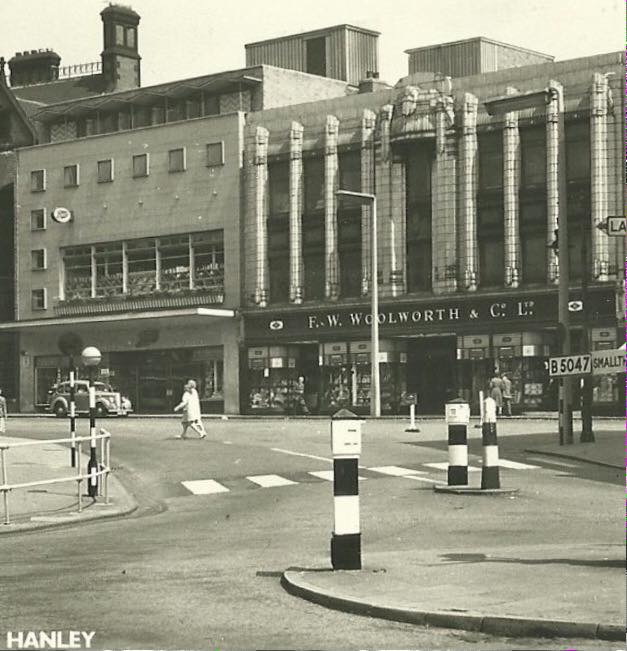 Hanley Woolworths 1950s
Hanley Woolworths 1950s
 Hanley Woolworths 1958
Hanley Woolworths 1958
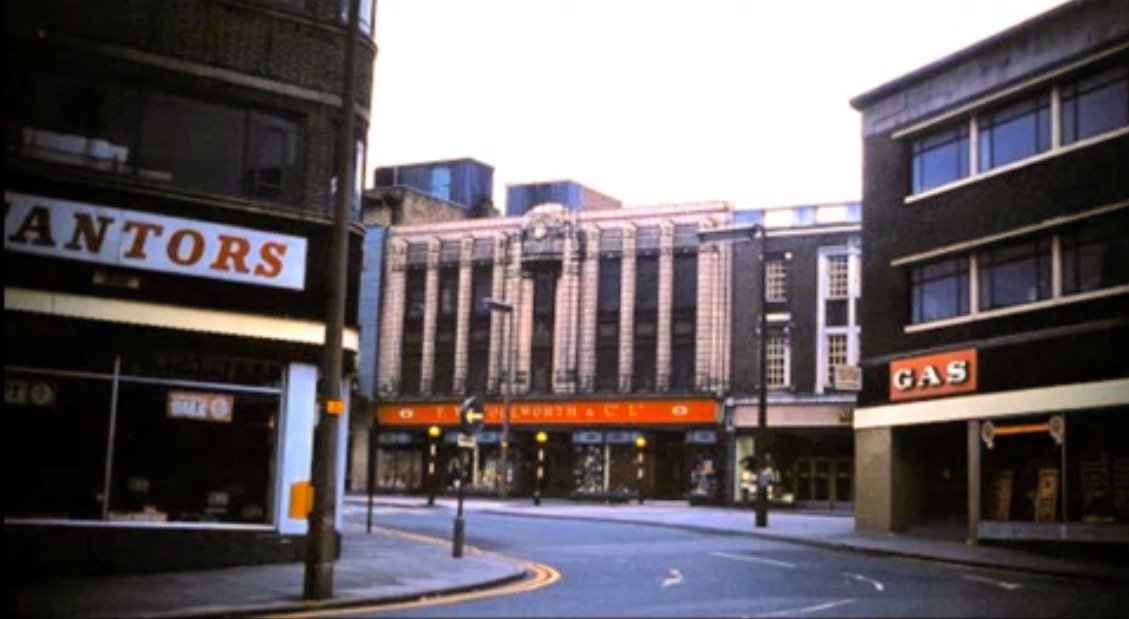 Hanley Woolworths 1960s
Hanley Woolworths 1960s
Source: Pinterest
In the 1970s the store was modernised along with the conversion to self-service. A typical frontage design was to have long narrow brick sections alternating with aluminium panels. As for the entrance, the display windows were moved to the sides and a panel of doors installed across the centre.
View original post 63 more words

